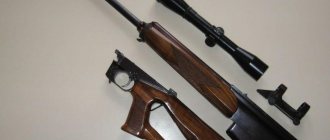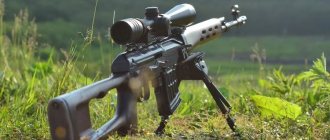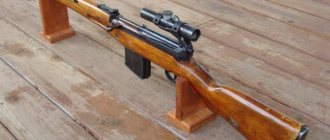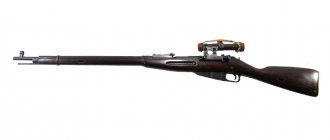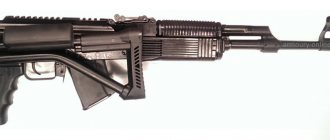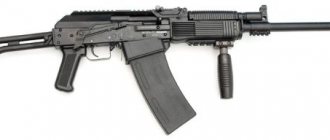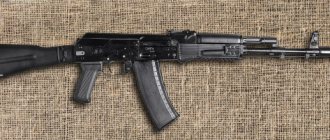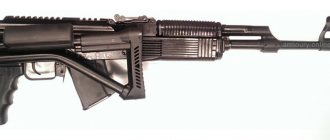The sample was taken as a 7.62 mm submachine gun of the 1941 model of the Shpagin system (PPSh) - a Soviet submachine gun developed in 1940 by designer G. S. Shpagin chambered for 7.62 × 25 mm TT and adopted by the Red Army December 21, 1940. The PPSh, along with the PPS-43, was the main submachine gun of the Soviet Armed Forces in the Great Patriotic War.
Georgy Semyonovich Shpagin (1897-1952) was a Soviet small arms designer whose most famous creation was the PPSh submachine gun. Hero of Socialist Labor (1945), laureate of the Stalin Prize (1941).
After the end of the war, by the mid-1960s, the PPSh was removed from service with the Soviet Army and gradually replaced by the Kalashnikov assault rifle; for a little longer it remained in service with rear and auxiliary units, units of internal troops and railway troops, until the collapse of the USSR in 1991. It is still in service with paramilitary security units and the Ministry of Internal Affairs of a number of CIS countries.
Also, in the post-war period, PPSh was supplied in huge quantities to countries friendly to the USSR, was in service with the armies of various states for a long time, was used by irregular forces and was used in armed conflicts around the world throughout the 20th century.
At the moment, it is sold to civilians as a hunting carbine for amateur shooting with minor modifications (the fire selector is welded in the position for single shots, a 10-round limiter is installed in the magazine, the muzzle and bolt cup in the firing pin area can be punched).
Conversion samples
- PPS-50 is a self-loading version chambered for the .22 LR small-caliber cartridge, produced by .
- SR-41 Semi-Auto Rifle - a self-loading version, produced since 2000 chambered for 7.62x25 mm and 9x19 mm. Features an elongated barrel.
- SKL-41 is a self-loading version chambered for 9x19 mm cartridge. Produced since 2008.
- PPSH 41 SemiAuto is a self-loading version chambered for 7.62×25 mm, with a barrel extended to 16 inches (completely covered by a barrel casing) and design changes (firing is carried out from a closed bolt). Produced (USA).
- VPO-135 is a self-loading carbine chambered for 7.62x25 mm, developed in 2013 by the Vyatsko-Polyansky Armory.
- PPSh-O is a self-loading carbine chambered for 7.62×25 mm, developed in 2013 by the Kovrov plant named after. V. A. Degtyareva.
- PPSh-Luger (MA 135 PS) is a self-loading carbine chambered for the 9×19 mm Luger cartridge, developed in 2014 by the Kovrov plant named after. V. A. Degtyareva. The barrel was replaced with a new one chambered for the 9×19 mm cartridge. Visually it differs from PPSh-O and VPO-135 in that it has a slightly longer barrel that fits into the front cutouts of the casing, forming a compensator.
- VPO-512 PPSh-M “Daddy” is a 4.5-mm air gas rifle, manufactured using the main parts of PPSh submachine guns (while maintaining all technical marks). Developed in 2007, produced since 2008 by the Vyatsko-Polyansky Armory
- MP-562K "PPSh" - 4.5 mm pneumatic gas rifle with the ability to fire in bursts, produced by the Izhevsk Mechanical Plant
The PPSh had not only advantages, but also disadvantages, such as large dimensions and weight, which significantly complicated the use of this weapon in narrow trenches and cramped spaces in urban battles, as well as by reconnaissance personnel, paratroopers and crews of combat vehicles. In addition, in wartime conditions it was necessary to reduce the costs of mass production of submachine guns.
In 1942, a competition was announced for a lighter, more compact and cheaper to produce submachine gun, not inferior to the PPSh in terms of characteristics. V. A. Degtyarev, G. S. Shpagin, N. V. Rukavishnikov, S. A. Korovin took part in the competition.
Source Photo PPSh2: https://topwar.ru/36276-ppsh-2-maloizvestnyy-pistolet-pulemet-shpagina.html
PPSh-2, despite the reduction in the number of parts compared to PPSh-41, did not become lighter than the base model. The weight of the PPSh-2 with a loaded magazine and additional equipment did not satisfy the customer. The Sudaev submachine gun won the competition.
PPSH-Luger - self-loading carbine chambered for 9x19 mm Luger (PPSH - Luger)
Developed in 2014 by the Kovrov plant named after. V. A. Degtyarev based on a 1941 model submachine gun designed by G.S. Shpagina (PPSh-41). The barrel was replaced with a new one, not chrome-plated, “black”, forged, chambered for 9x19 mm. Visually it differs from the PPSh-41 in that it has a longer barrel that fits into the front cutouts of the casing, forming a compensator. The carbine has design differences from the PPSh 41: 1. The fire selector is fixed (welded) in the single-fire firing position. 2. The screw (dowel) holding the assembly, trigger, box, butt is welded. 3. Magazine capacity is limited to 10 pieces. 4. A non-chrome-plated barrel for 9x19 caliber is installed. The number of cuts is 6 in increments of 250.
TTX:
| Constructor: | Georgy Semyonovich Shpagin (1897-1952) |
| Developed (PPSh-41): | 1940 |
| Caliber: | 9x19 Luger |
| Weapon length: | 843 mm |
| Barrel length: | 269 mm |
| Weight without cartridges: | 3.6 kg |
| Weapon width: | 145 mm |
| Weapon height: | 195 mm |
| Magazine capacity: | 10 rounds |
three types of sector magazines for PPSh (late-smooth, early-ribbed, early-ribbed with influx)
All drum magazines, as well as sector magazines, fit 9X19 mm caliber without modification.
in the photo: Early and later drum-type magazines.
How the German military responded to captured PPSh
During the Great Patriotic War, the Shpagin submachine gun became the most popular submachine gun in the Red Army.
And this was no accident. The weapon earned a lot of positive feedback, including from enemies - German soldiers. Like German weapons given to Soviet soldiers, our submachine guns also sometimes ended up with the Germans as trophies. The Wehrmacht soldiers were quite surprised by the excellent characteristics of the PPSh-41. Maschinenpistole 717(r) - that’s exactly what the Germans called PPSh-41, with a small letter “r” - “Russian” in brackets.
Thus, firing from a Soviet submachine gun created a high density of fire, the rate of fire was higher than that of the MP-40. The sighting range also differed favorably. In addition, which was very important, the 71-round magazine made it possible to achieve a significant advantage: the Wehrmacht soldier had to change two MP-40 magazines, and the Red Army soldier during this time shot only one PPSh disc.
After the same period of time, there was still a significant supply of ammunition left,” and this turned out to be decisive for the outcome of some battles,
- write German authors Rainer Liedschun and Günter Wollert in the book “Small Arms Yesterday (1918–1945).”
Another undoubted advantage of the PPSh-41 was its massive wooden butt. Thanks to him, the submachine gun turned into an excellent weapon for hand-to-hand combat. German soldiers, armed with an MP-40 with a folding stock, had nothing to oppose the PPSh if they had to get into hand-to-hand combat. Soviet soldiers affectionately called Shpagin’s submachine gun “Daddy,” and German soldiers called it “small machine gun.”
We tried to get a Russian “small machine gun”. The disk held, I think, 72 rounds, and if well maintained it was a very formidable weapon. In general, Russian weapons were valued for their simplicity and reliability. But it was very poorly protected from corrosion and rust. Our weapons were better processed,
- recalled a Wehrmacht corporal who had the opportunity to fight near Moscow.
The PPSh was also distinguished by its simplicity: one of the former SS soldiers recalled after the war that it was possible to learn the principle of disassembling a Soviet submachine gun very quickly; no instructions were required.
Since the number of submachine guns and machine guns in Wehrmacht units was, contrary to popular myth, less than in the Red Army, German soldiers were very happy when they had the opportunity to acquire a captured Shpagin “small machine gun.” After all, a company, as a former Wehrmacht soldier recalls, had an average of 15-20 machine guns, and the rest of the soldiers were armed with carbines. Naturally, in such a situation, the PPSh, even with certain shortcomings, was still the best weapon.
The popularity of the PPSh in parts of Hitler's troops was so significant that in October 1942, SS Obergruppenführer Felix Martin Julius Steiner, commander of the SS Viking division, turned to Heinrich Himmler with a proposal to launch the production of submachine guns similar to the Soviet PPSh at German factories.
Russian machine guns are widely used in our division; they have proven themselves to be very reliable even in the most unfavorable conditions,
- the SS Obergruppenführer wrote to his boss.
Himmler gave the go-ahead to modify the PPSh for the standard 9x19 mm cartridge used by the Wehrmacht. The new weapon was called MP-41(r). Arms factories promptly produced 10 thousand barrels for Soviet PPSh. Converted PPShs were especially often used in the “elite” SS divisions. The enemy knew a lot about weapons and spoke of the PPSh with respect. Of course: 900 rounds per minute from PPSh versus 500 from MP! There is a difference?
Review:
Automation works according to the scheme of using recoil with a free shutter. The fire is fired from the rear sear (the bolt is in the rearmost position before firing, after release it goes forward, chambers the cartridge, the primer is pierced at the moment chambering is completed), the bolt is not fixed at the moment of firing. A similar scheme is often used in the development of submachine guns. Despite its simplicity, such a solution requires the use of a massive bolt, which increases the total weight of the weapon. In addition, a weapon using such a reloading scheme can fire as a result of a strong impact (for example, when falling), if the impact causes the bolt to roll back along the guides from the extreme forward (non-fixed) position further than the magazine's cartridge feed window, or from the extreme rear one to break off. stopper
The firing pin is placed motionless in the shutter mirror. The translator is located inside the trigger guard, in front of the trigger. The safety is a slider located on the bolt cocking handle. When the safety is on, it locks the bolt in the forward or rear position.
Like the PPD, the PPSh has a receiver fused with the barrel casing, a bolt with a safety on the cocking handle, a fire selector in the trigger guard in front of the trigger, a flip-up sight and a wooden stock. But at the same time, the PPSh is significantly more technologically advanced: only the barrel requires precise machining, the bolt was made on a lathe followed by rough milling, and almost all other metal parts can be made by stamping.
The muzzle brake-compensator is a part of the barrel casing protruding forward beyond the muzzle (a beveled plate with a hole for the passage of a bullet, on the sides of which there are through windows in the casing). Due to the reactive action of powder gases when fired, the muzzle brake-compensator significantly reduces recoil and “lifting” of the barrel upward.
The stock was made of wood, mainly birch. PPSh-41 was first equipped with drum magazines from the PPD-40 with a capacity of 71 rounds. But since drum magazines in combat conditions proved to be unreliable, excessively heavy and expensive to manufacture, and also required manual individual adjustment for each specific submachine gun, they were replaced by sector magazines developed in 1942 with a capacity of 35 rounds.
Sights initially consisted of a sector sight (with a range of 50 to 500 m and a pitch of 50 m) and a fixed front sight. Later, a flip-over L-shaped rear sight was introduced for shooting at 100 and 200 meters. Since the sighting range is an exclusively conditional, subjective characteristic, the PPSh of early production, like most pre-war submachine guns, had a sector sight marked up to 500 meters, but subsequently a simplified version was produced with a sight up to 200 meters - while the characteristics of the weapon itself were de - in fact remained the same, but the new sight was much easier to manufacture and was fully consistent with the real combat use of this weapon.
PPSh - hunting carbine?
Photo by the author
But laugh with laughter, and this weapon can now be purchased at a hunting store as a hunting carbine. This is due, first of all, to our legislation; we have no other ways to certify rifled weapons for civilian use.
And since you can buy him, I think it wouldn’t hurt our hunters and shooters to get to know this interesting veteran better.
Many people ask: why is the PPSh so big, massive and, as it seems to them, too brutal? Look at the MP-40 - light, delicate, relatively compact - but they are analogues. This is not an entirely correct statement; the MP was designed as an airborne weapon and for the crew of armored vehicles, as an additional weapon for an officer.
Our PPSh was originally created as the main weapon of the infantry, the design was extremely simple and cheap, by the way, according to the conditions, it was intended to be used in hand-to-hand combat, hence the excessive power of the stock and massive metal parts. Read the memoirs of Wehrmacht soldiers, what do we see?
Constant “moans” that the MP is useless in hand-to-hand combat, if you run out of cartridges, you can only use it as a club, grabbing it by the barrel, but in this case the aluminum handle often breaks. In general, this is understandable; no one envisaged such a possibility. These are different weapons based on their areas of application.
But these are all things of the past; in this article we will talk about the PPSh-Luger. This option, it seems to me, is the most interesting today, since it makes it possible to shoot a lot with a relatively inexpensive cartridge. Our industry has never been able to put the once massive 7.62x25 TT into production. The cheapest Tehkrim cartridge costs 25 rubles, and Fiocchi costs 55 rubles. There are no others on sale or expected.
There are plenty of 9x19 cartridges on sale, at prices starting from 7 rubles, and shooting them is not so expensive. It should be noted that shooting from a PPSh, of any caliber, is quite an exciting activity, there is practically no recoil, and there is also no forward push during the shutter run, which you clearly feel during idle release. It’s reminiscent of shooting from a pneumatic rifle - click, click, only the cartridges fly. More time is spent equipping stores.
By the way, the Germans came up with the idea of converting PPSh for the 9x19 cartridge, this is understandable. Logistics have been simplified; supplying troops with one type of ammunition is always easier. To adapt, it is enough to change the barrel; feeding occurs with almost the same reliability, despite the fact that the 9x19 cartridge is somewhat shorter - 7.62x25.
But the Germans would not be Germans if they stopped there. To replace the barrel, they added a special adapter, which was removable, which allowed the use of standard magazines from the MP-40, further simplifying logistics; now the magazine on the PPSh became German.
Everything is simple, if there are 6 submachine guns in a company, issue the required number of magazines and sets of cartridges, there is no need to figure out who has converted PPSh and who has MP. The Germans themselves write that the sight of a PPSh with a disc, especially among policemen and others, without a uniform made soldiers nervous - what if it was a partisan? And so, the store is direct - its own, and indeed the appearance of the PPSh with the MR store is very unique, you can’t confuse it with anything.
But we digress, as the reader has probably already guessed, our manufacturer stopped after the first step, that is, he changed the barrel to 9 mm, and all that can be done, this is not Germany. But Russia is strong in craftsmen, and replicas of the adapter immediately appeared, I bought one of them and installed it, it turned out very well.
The adapter had to be altered a little to fit the magazine from VIG, they are almost a complete analogue of the MP, but cost 900 rubles, while the original MP cost 4500. There were minor flaws, but they were “treated” simply and quickly with a needle file. In the end, everything turned out nice and worked.
Here we must also take into account that the magazines must be 10-round, so the disk magazine does not benefit in any way, and with “horns” it is even more convenient to hold the carbine. In general, it turned out to be an interesting, somewhat unusual, carbine for recreational shooting.
In conclusion, I think it will be interesting to dwell on the features of converting PPSh into civilian carbines. There are three options: VPO-135, now it is almost impossible to find it, these are the first converted PPSh, they have a slightly welded fire switch, a butt mounting screw and a crimp mark on the barrel in the form of a 2-3 cm nick before the exit. In addition, there is a small mark on the shutter mirror for punching cartridges.
The second sample is PPSh-O, the changes are similar, but there is not a nick in the barrel, but a welded pin, approximately in the middle of the barrel. The welding on the translator is massive, the rest is similar. PPSh-Luger - welding on the translator, a mark on the bolt, a coupling bolt is also welded, the barrel is new, forged, 9 mm, without flaws, since it meets all the criminal requirements initially. As you can see, the changes are minimal, what is better or what is worse is decided by the user himself and votes with rubles.
A carbine with its own characteristics, pros and cons, but one thing is for sure: it’s good that it has become possible to buy a shooting PPSh, and even in different calibers.
So should we consider the PPSh a hunting carbine or not? I remembered one phrase said by an experienced photographer. When he was asked whether a camera could be considered professional if its matrix was not 36x24 mm, but 24x18, he always had the same answer: “A professional camera is a device that a professional takes pictures with. No camera can make a professional out of its owner; on the other hand, an experienced photographer will be able to take decent photos with almost any camera.”
Alexander Kudryashov October 5, 2015 at 11:22 am

